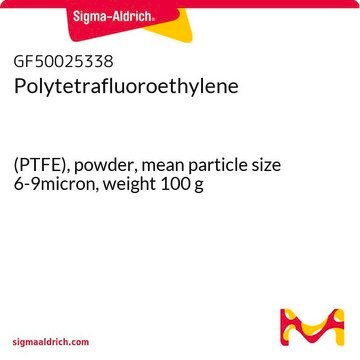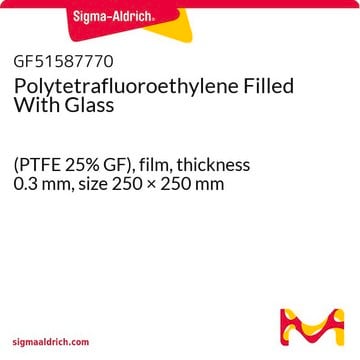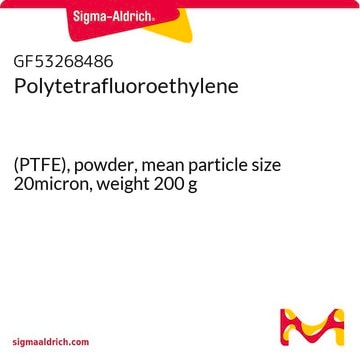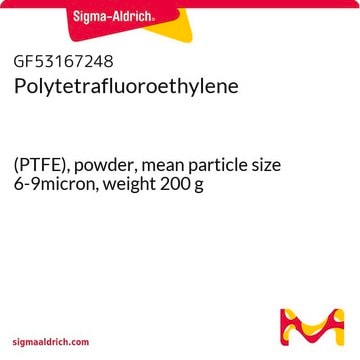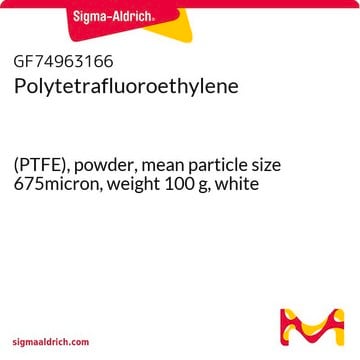Precipitates may form over time while standing and can be re-dispersed by gentle agitation. Containers may be rolled or the product shaken gently just before use. High-speed agitation, pumping, or other violent agitation should be avoided to limit shearing or coagulation of particles and to minimize foaming. Precipitation may also occur if the product undergoes vigorous agitation or is exposed to high or low temperatures. The recommended temperature range is +7 to +24 °C. If particulates remain after gentle mixing, it may indicate irreversible aggregation. For further discussion, please visit https://www.sigmaaldrich.com/techservice and click on "Product Technical Inquiries" under the Products Section with all the required information for assistance from the Technical Service team.
665800
Polytetrafluoroethylene preparation
60 wt % dispersion in H2O
Sinônimo(s):
PTFE dispersion
About This Item
Produtos recomendados
Nível de qualidade
concentração
60 wt % dispersion in H2O
cadeia de caracteres SMILES
FC(=C(F)F)F
InChI
1S/C2F4/c3-1(4)2(5)6
chave InChI
BFKJFAAPBSQJPD-UHFFFAOYSA-N
Procurando produtos similares? Visita Guia de comparação de produtos
Categorias relacionadas
Descrição geral
Aplicação
The invariance of the dielectric constant over a wide frequency range and the high dielectric strength of PTFE makes it a suitable material for cable insulation and high-temperature energy storage application.
It can also be employed as an easy-cleaning, chemically inert, and non-stick coating in food, chemical and pharmaceutical industries.
Características e benefícios
- High chemical resistivity
- Low coefficient of friction
- Flexibility
- High thermal stability
Palavra indicadora
Danger
Frases de perigo
Declarações de precaução
Classificações de perigo
Eye Dam. 1
Código de classe de armazenamento
10 - Combustible liquids
Classe de risco de água (WGK)
WGK 3
Ponto de fulgor (°F)
Not applicable
Ponto de fulgor (°C)
Not applicable
Equipamento de proteção individual
Eyeshields, Gloves, type ABEK (EN14387) respirator filter
Escolha uma das versões mais recentes:
Certificados de análise (COA)
Não está vendo a versão correta?
Se precisar de uma versão específica, você pode procurar um certificado específico pelo número do lote ou da remessa.
Já possui este produto?
Encontre a documentação dos produtos que você adquiriu recentemente na biblioteca de documentos.
Os clientes também visualizaram
-
When the emulsion was delivered, there was sediment at the bottom. Is this normal, or is it defective?
1 answer-
Helpful?
-
-
What is the viscosity of the dispersion?
1 answer-
The viscosity of this material is not tested on a lot-to-lot basis. However, historical data indicates a viscosity of approximately 20 cP at 25°C.
Helpful?
-
-
How is shipping temperature determined? And how is it related to the product storage temperature?
1 answer-
Products may be shipped at a different temperature than the recommended long-term storage temperature. If the product quality is sensitive to short-term exposure to conditions other than the recommended long-term storage, it will be shipped on wet or dry-ice. If the product quality is NOT affected by short-term exposure to conditions other than the recommended long-term storage, it will be shipped at ambient temperature. As shipping routes are configured for minimum transit times, shipping at ambient temperature helps control shipping costs for our customers. For more information, please refer to the Storage and Transport Conditions document: https://www.sigmaaldrich.com/deepweb/assets/sigmaaldrich/marketing/global/documents/316/622/storage-transport-conditions-mk.pdf
Helpful?
-
-
How can I determine the shelf life / expiration / retest date of this product?
1 answer-
If this product has an expiration or retest date, it will be shown on the Certificate of Analysis (COA, CofA). If there is no retest or expiration date listed on the product's COA, we do not have suitable stability data to determine a shelf life. For these products, the only date on the COA will be the release date; a retest, expiration, or use-by-date will not be displayed.
For all products, we recommend handling per defined conditions as printed in our product literature and website product descriptions. We recommend that products should be routinely inspected by customers to ensure they perform as expected.
For products without retest or expiration dates, our standard warranty of 1 year from the date of shipment is applicable.
For more information, please refer to the Product Dating Information document: https://www.sigmaaldrich.com/deepweb/assets/sigmaaldrich/marketing/global/documents/449/386/product-dating-information-mk.pdfHelpful?
-
-
Hi, Could you please let me know the density of the solution and the size of the PTFE particles in the solution? Thanks.
1 answer-
The density of this product is not determined on a lot to lot basis. However, a 60 wt% dispersion will have a density of 1.5 g/mL. The concentration of this dispersion may vary slightly from lot to lot. The particles have an average diameter of 0.220 um and may range from 0.150 - 0.500 um.
Helpful?
-
-
Hi, Can you tell me if this product is AD 309 E PTFE dispersion from AGC?
1 answer-
Unfortunately, the supplier information is considered proprietary. The measured properties are published in the product Certificate of Analysis. Please see the link below to review a sample or lot-specific Certificate:
https://www.sigmaaldrich.com/product/aldrich/665800#product-documentationHelpful?
-
-
What is the boiling point of the product?
1 answer-
This product is a 60% dispersion of PTFE in water. The boiling point has not been determined. The PTFE particles may settle at temperatures greater than 66°C, but can be redispersed by mild agitation. The melting peak temperature for these particles is 337°C.
Helpful?
-
-
What is the molecular weight of the polymer?
1 answer-
Unfortunately, the molecular weight of this product is not determined.
Helpful?
-
-
What are the recommended processing conditions for 665800-100ML?
1 answer-
The product 665800 PTFE dispersion retains its properties after exposure to 260 °C (500 °F). Processing guidelines entail using conventional dip or flow techniques for coating or impregnating high-temperature fabrics, fibers, and other products. Multiple passes can be used to achieve the desired thickness for a smooth, crack-free coating. Each coating layer is typically dried at 120 °C (250 °F) to remove water, baked at 270 °C (518 °F) to eliminate the wetting agent, sometimes calendered, and finally heated above the crystalline melting point of the resin particles, which is approximately 337 °C (639 °F).
Helpful?
-
-
what is the curing temperature? if it used to make thin film for detect oxygen concentration of aqueous
1 answer-
665800 is PTFE dispersion in water. The curing temperature depends on its further applications. Generally, 80-100 °C should be good. Unfortunately, it hasn't been tested for the application of oxygen concentration detection.
Helpful?
-
Active Filters
Nossa equipe de cientistas tem experiência em todas as áreas de pesquisa, incluindo Life Sciences, ciência de materiais, síntese química, cromatografia, química analítica e muitas outras.
Entre em contato com a assistência técnica

![Poly[4,5-difluoro-2,2-bis(trifluoromethyl)-1,3-dioxole-co-tetrafluoroethylene] dioxole 87 mol %](/deepweb/assets/sigmaaldrich/product/structures/951/320/21327fcd-4960-402d-8ae1-bf2e379cb2e2/640/21327fcd-4960-402d-8ae1-bf2e379cb2e2.png)
